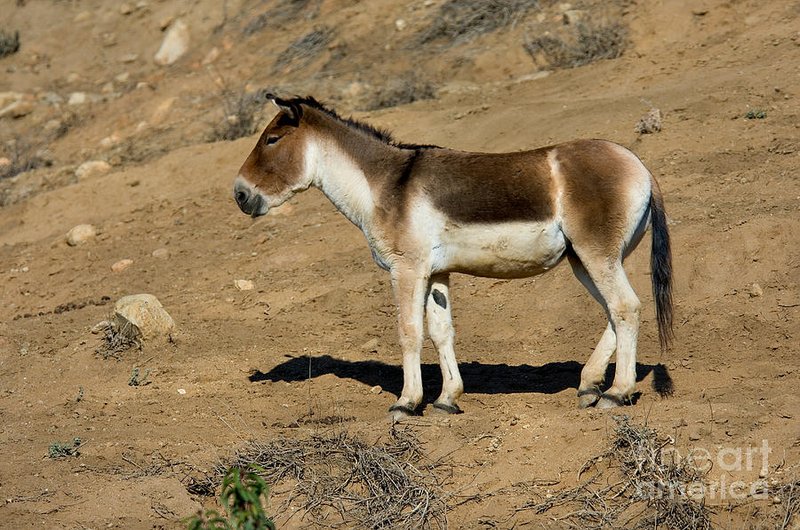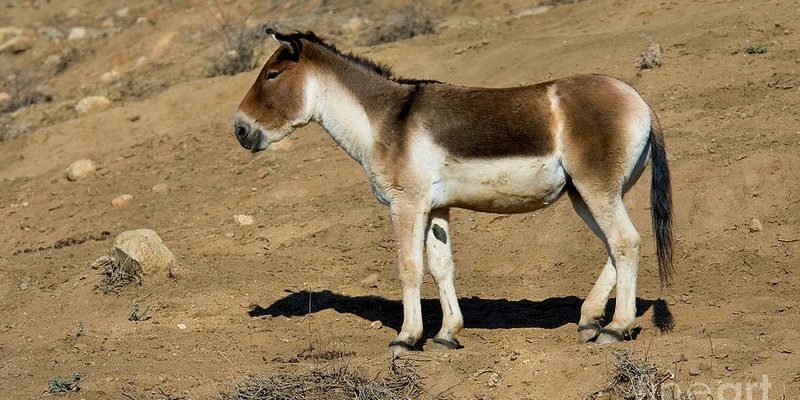
The Kiang, often called the Tibetan wild ass, is a fascinating creature that roams the rugged terrains of the Tibetan Plateau. Picture a striking animal with a sturdy build, long legs, and a graceful demeanor. These creatures can grow up to 4.5 feet tall at the shoulder and weigh around 600 pounds, making them quite sizable compared to regular donkeys. With their sleek bodies and distinctive reddish-brown coats, Kiangs are a sight to behold against the stunning backdrop of the high-altitude landscape.
You might be wondering why these animals are so special. Well, Kiangs are not just another hoofed mammal; they are uniquely adapted to thrive in harsh climates. For instance, they have a thick layer of fur that keeps them warm in frigid temperatures, and they can even survive on limited water and food sources. This ability to endure extreme conditions has made them a symbol of resilience in the Tibetan ecosystem.
Physical Characteristics
When you look at a Kiang, the first thing that grabs your attention is their magnificent appearance. Their bodies are built for speed and endurance, with long legs that can carry them swiftly across the Tibetan grasslands. The Kiang’s coat, a beautiful shade of chestnut to dark brown, is not just for looks—it also provides excellent insulation against the cold.
Another notable feature is their distinctive stripe pattern. Kiangs have a light-colored stripe running down their back and a darker stripe along their legs. These markings help them blend into the rocky terrain, offering some camouflage from predators. Their big, expressive eyes and long ears also contribute to their charming appearance, making them truly unique members of the equine family.
Habitat and Range
Kiangs predominantly reside in the expansive and rugged regions of the Tibetan Plateau, which is famous for its high-altitude habitats. They prefer environments that offer vast open spaces, such as grasslands and steppes, where they can roam freely and graze on the vegetation that thrives in these areas. You can often find them in altitudes ranging from 10,000 to 15,000 feet above sea level.
Interestingly, Kiangs are social animals, often seen in groups called harems. These harems typically consist of one male and several females. The social structure of Kiangs allows them to work together to protect themselves from potential threats, including wolves and snow leopards, which are their main predators in this rugged landscape.
Diet and Feeding Habits
Let’s talk about what makes up a Kiang’s diet. As herbivores, these animals primarily feast on grasses, shrubs, and other vegetation found within their habitat. What’s fascinating is their ability to digest tough and fibrous plant material. Their digestive systems are uniquely adapted to extract the nutrients they need, even from inferior forage.
Kiangs are also quite resourceful. During dry spells, when food is scarce, they can change their diet to include more drought-tolerant plants. Sometimes, they’ll even dig through the snow in winter to get to the grass below. This adaptability is key to their survival in such a challenging environment.
Behavior and Social Structure
Generally, Kiangs are quite active and social creatures. They are known for their playful behavior, often seen engaging in friendly sparring matches within harem groups. These interactions are not only fun to watch but also play a significant role in establishing social hierarchies among the males.
The social structure of Kiangs is fascinating. The dominant male of a harem is responsible for protecting his females and their young from predators. This protective behavior shows a level of social complexity, as the male uses various vocalizations and body language to communicate with the group. You might even hear their characteristic bray, which is quite similar to a donkey’s, echoing through the valleys.
Reproduction and Lifespan
Kiangs typically breed during the summer months, with a mating season that can last from June to August. After a gestation period of about a year, a single foal is usually born, which is a crucial time for both the mother and her young. The foal is able to stand and walk within just a few hours of birth, allowing it to join the group and start learning survival skills almost immediately.
In terms of lifespan, Kiangs can live for about 20 years in the wild, though those in captivity often live longer due to the absence of predators and consistent food supply. Their longevity can also be attributed to the strong social bonds they form within their harems, which provide protection and support throughout their lives.
Conservation Status
Currently, the Kiang is listed as “Near Threatened” on the IUCN Red List. Their population has seen significant fluctuations due to habitat loss and competition for resources from livestock grazing. Conservation efforts are underway to protect these remarkable animals and their habitats, focusing on sustainable land use and habitat preservation.
Efforts by local governments and conservation groups aim to raise awareness about the importance of preserving the Kiang’s natural environment. This is especially crucial as climate change poses new challenges to their already fragile ecosystem. By maintaining their habitat, we can help ensure that these stunning creatures continue to thrive in the wild.
Interesting Facts About Kiangs
| Scientific Name: | Equus kiang |
| Size: | Up to 4.5 feet tall at the shoulder |
| Weight: | Approximately 600 pounds |
| Habitat: | Tibetan Plateau, high-altitude grasslands |
| Diet: | Grasses, shrubs, and drought-tolerant plants |
| Lifespan: | 20 years in the wild |
FAQ
What is the Kiang’s primary diet, and how does it affect their habitat?
The Kiang primarily feeds on grasses and shrubs found in their natural habitat on the Tibetan Plateau. Their diet impacts the local vegetation, as they graze on the grasses, which can help shape the ecosystem. This grazing behavior can prevent certain plants from dominating the landscape, promoting a diverse range of plant life.
Are Kiangs social animals?
Yes, Kiangs are known for their social behavior. They form groups called harems, typically consisting of a dominant male and several females. These social structures allow them to protect each other from predators and engage in playful interactions. Their social bonds are critical for the survival of the group, especially when it comes to rearing young foals.
How do Kiangs communicate with each other?
Kiangs communicate through various vocalizations and body language. Their braying sounds, reminiscent of a donkey’s, can convey different messages, such as alerting the group to danger or signaling their presence. Body movements, like posturing during sparring matches, also play an essential role in establishing dominance and social hierarchies.
What are the main threats to Kiangs?
The Kiang faces threats primarily from habitat loss and competition with livestock for grazing areas. In recent years, climate change has also become a significant concern, as altering weather patterns can affect food availability and the overall health of their habitat. Additionally, poaching poses risks, although conservation efforts are in place to help mitigate these issues.
How do Kiangs adapt to their harsh environment?
Kiangs have several adaptations that allow them to thrive in the harsh conditions of the Tibetan Plateau. They possess a thick coat of fur to keep warm and are capable of surviving on limited water and food sources. Their ability to dig through snow to find grass also showcases their resourcefulness, ensuring they can access food even in winter.
Can Kiangs be found in zoos or wildlife parks?
Yes, some Kiangs can be found in zoos and wildlife parks, particularly those focused on conservation. In these settings, they often live longer due to the absence of predators and consistent access to food. These facilities also play a crucial role in educating the public about the species and the challenges they face in the wild.
What is the typical lifespan of a Kiang?
In the wild, Kiangs typically live for about 20 years, although some may live longer in protected environments. Factors like predators, food availability, and environmental conditions can impact their lifespan significantly in the wild, while those in captivity often enjoy a safer and more stable life.
How do conservation efforts help Kiangs?
Conservation efforts aim to protect the Kiang’s natural habitat and ensure their survival in the wild. Strategies include promoting sustainable land use, raising awareness about their ecological importance, and protecting key habitats from degradation. By focusing on habitat preservation, conservationists hope to reduce competition with livestock and mitigate the impacts of climate change.
Are Kiangs endangered?
While Kiangs are not currently classified as endangered, they are listed as “Near Threatened” on the IUCN Red List. Their populations fluctuate due to various environmental pressures, so ongoing conservation efforts are essential to maintain healthy populations and ecosystems.
What unique behaviors do Kiangs exhibit?
Kiangs are known for their playful nature and social interactions. They often engage in sparring matches with one another, which helps establish social hierarchies within harems. Such behaviors not only strengthen group bonds but also play a role in mate selection and reproductive success. Their interactions are quite fascinating to observe from a distance!
Where can I see Kiangs in the wild?
If you’re hoping to see Kiangs in their natural habitat, your best bet is to visit the high-altitude regions of the Tibetan Plateau. Specific areas in Tibet or parts of India and Nepal, where they roam freely, offer opportunities to catch a glimpse of these majestic animals. Wildlife tours focusing on the Tibetan Plateau often include visits to areas known for Kiang sightings.

